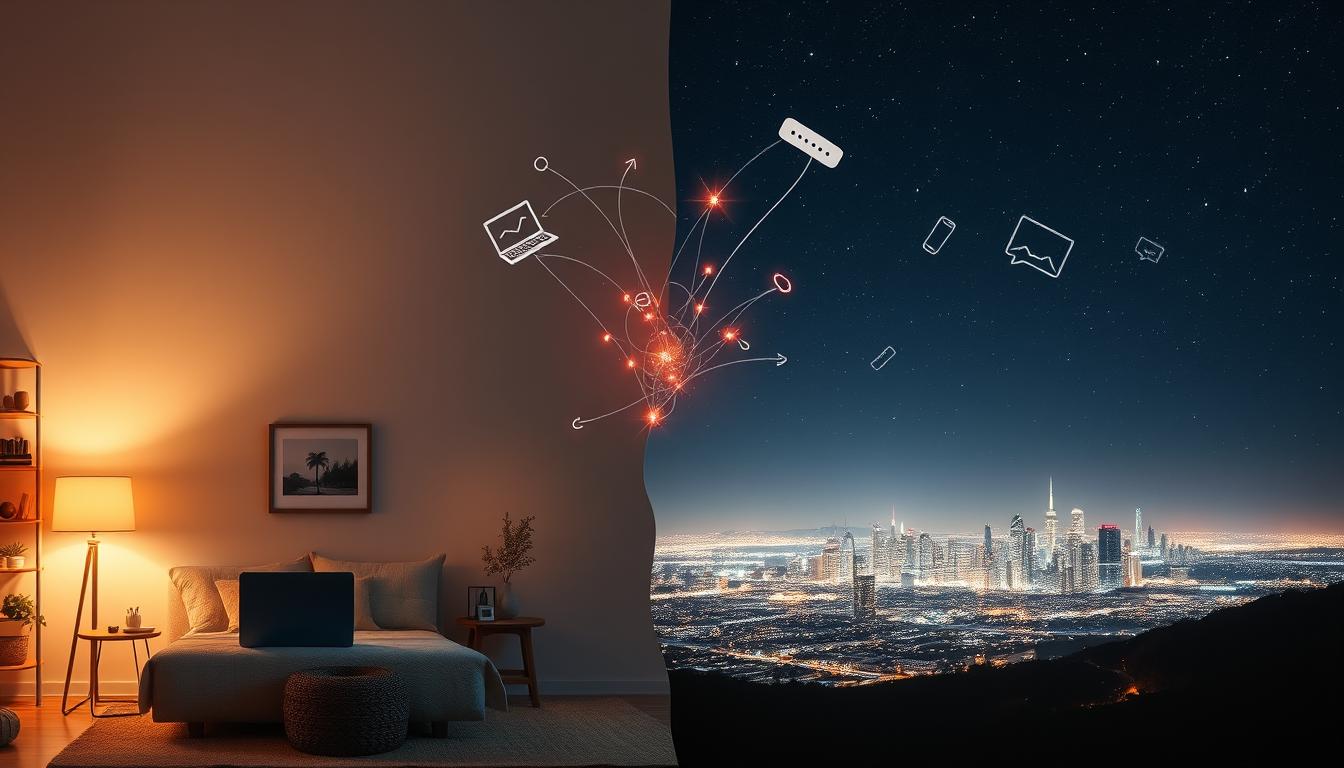As I sit here, miles away from the one I love, a deep longing fills my heart. Long-distance relationships test our endurance and the depth of our love. We’ll delve into the hurdles, strategies, and benefits of keeping a relationship alive despite the distance.
Our bond can conquer time and space. By navigating long-distance relationships with purpose, creativity, and steadfast dedication, we can forge a connection that defies physical barriers. We’ll discover how to keep intimacy alive, plan virtual dates, and use communication tactics to keep the flame burning.
Key Takeaways
- Embrace the unique challenges and opportunities of long-distance relationships
- Develop trust-building exercises to maintain emotional intimacy
- Manage expectations and find creative ways to cope with loneliness
- Prioritize surprise visits and shared experiences online
- Nurture a long-term commitment to weathering the distance
The Challenges of Long-Distance Love
Long-distance relationships face unique hurdles, especially in overcoming physical separation and maintaining emotional closeness. The absence of daily face-to-face interactions can strain couples, as each meeting becomes a chance to make up for lost time. The physical gap also fuels unmet needs for closeness and can lead to misunderstandings.
Overcoming Physical Separation
Overcoming physical distance in a long-distance relationship demands effort and creativity. Couples must find ways to bridge the gap, like scheduling regular video calls, sending care packages, or planning surprise visits. Trust and open communication are key to addressing these challenges.
Maintaining Emotional Intimacy
Maintaining emotional closeness in a long-distance relationship is as vital as physical intimacy. Couples must explore new ways to stay connected, such as sharing daily updates, engaging in meaningful conversations, or enjoying shared hobbies virtually. Addressing unmet needs and combating loneliness are crucial for preserving the emotional bond.
“The distance can also provide space for individual growth and self-discovery, as each partner learns to navigate life independently while still being part of a committed relationship.”
The challenges of long-distance love are not insurmountable. With effective communication, a commitment to emotional intimacy, and a willingness to overcome physical separation, couples can navigate the distance and strengthen their bond.
Always Have Something to Look Forward To Together
In long-distance relationships, keeping the spark alive is key. It’s vital to have shared goals and milestones to work towards together. This not only keeps the relationship vibrant but also reminds you that the distance is just temporary. It’s a reminder that better times are ahead.
Planning future visits and experiences is a great way to keep the excitement alive. It could be a weekend trip, a vacation, or even a plan to live together someday. Having these future milestones to look forward to keeps the enthusiasm high. It also strengthens the bond, even when you’re apart.
It’s also crucial for long-distance couples to regularly talk about their shared goals and converging trajectory. This ensures they’re both moving in the same direction. Regular check-ins and honest talks about their dreams help keep the relationship on track. It prevents it from drifting apart due to lack of direction.
“The secret of change is to focus all of your energy, not on fighting the old, but on building the new.”
By maintaining enthusiasm and a shared purpose, long-distance couples can overcome the challenges of being apart. They can continue to grow their relationship, even from a distance.
| Strategies to Maintain Enthusiasm in Long-Distance Relationships | Benefits |
|---|---|
|
|
Be Slow to Judge
In long-distance relationships, it’s crucial to avoid irrational assumptions about your partner’s behaviors or intentions. Physical separation and limited exposure can lead to jumping to conclusions. This can result in unfounded jealousy, overly critical judgments, or idealized perceptions of the partner.
To maintain objectivity and healthy communication, it’s important to manage jealousy and maintain open and honest dialogue with your partner. Regular check-ins, sharing concerns, and seeking clarification can help prevent misunderstandings. This improves communication in your long-distance relationship.
Avoiding Irrational Assumptions
When distance separates you from your partner, it’s natural to fill in the gaps with your own imagination. However, this can often lead to irrational assumptions that may not reflect the true situation. Be mindful of your thought patterns and resist the urge to jump to conclusions without clear evidence.
- Recognize when your assumptions may be colored by your own insecurities or fears.
- Communicate openly with your partner to understand their perspective and experiences.
- Cultivate a spirit of curiosity and maintain objectivity when interpreting your partner’s actions or words.
By avoiding irrational assumptions and fostering open communication, you can build trust, deepen your emotional connection, and navigate the challenges of long-distance love more effectively.
Make Communication Optional
In long-distance relationships, communication should flow naturally, without forced rules or obligations. Forcing communication can result in shallow, filler-filled interactions and resentment. Instead, partners should have the freedom to choose when to communicate, using their partner’s desire for it as a gauge of the relationship’s progress.
Avoiding forced communication is key to maintaining healthy boundaries and organic communication. It empowers partners to take breaks from constant contact, allowing them to recharge. This way, they can approach their next conversation with renewed energy and enthusiasm.
By making communication optional, couples can better manage their resentment levels. This prevents the relationship from becoming a source of stress or burden. It fosters a sense of trust and mutual respect, where each partner’s needs and boundaries are respected.
“The key to successful long-distance relationships is finding a balance between staying connected and respecting each other’s need for independence.”
The goal is to nurture a vibrant, supportive relationship, not to compel constant contact. By embracing the freedom to communicate organically, couples can build a deeper, more meaningful connection. This connection can withstand the challenges of physical distance.
| Forced Communication | Optional Communication |
|---|---|
| Leads to resentment and half-hearted interactions | Fosters trust, mutual respect, and organic connection |
| Can create a sense of burden and stress | Allows partners to recharge and approach conversations with renewed energy |
| Undermines the relationship’s natural progress | Uses partner’s desire for communication as a barometer for the relationship |
Ensure the Distance is Temporary
For a long-distance relationship to succeed, a shared future vision and a clear reunification plan are crucial. Without a common path forward, the bond may feel empty and will likely fail. Both partners must be committed to reuniting, with a mutual understanding of the timeline and strategy.
Shared Vision for the Future
In a long-distance relationship, aligned life goals and a shared vision for the future are essential. This means both individuals must agree on the relationship’s outcome, whether it’s marriage, starting a family, or living together. Regular talks about working towards reunification keep hope alive and give the relationship purpose.
Couples should have a detailed plan for bridging the temporary distance. This could involve one partner moving, both relocating, or alternating stays in each other’s hometowns. The important thing is to have a solid plan both are eager to follow.
“Without a clear plan and a converging trajectory, the relationship is likely to feel meaningless and eventually fall apart.”
Long-distance relationships demand unwavering dedication and a strong commitment to the shared vision. By aligning their goals and working towards reunification, couples can overcome the hurdles of distance and forge a lasting bond.
Setting Realistic Expectations
Entering a long-distance relationship demands setting clear expectations from the start. It’s essential for partners to discuss their communication needs, expectations for dating and quality time, and how to handle unmet expectations. This proactive approach helps in building a strong bond despite the distance.
Discussing Communication Needs
Clear communication guidelines are vital in a long-distance relationship. Couples should agree on how often and how they will communicate. This includes deciding on the frequency of calls, preferred communication channels, and boundaries around response times.
Dating and Quality Time Expectations
Aligning on dating and quality time expectations is crucial. Couples need to plan visits, set visit durations, and find ways to stay intimate despite the distance. Creativity in sharing experiences is key to maintaining a strong connection.
| Expectation | Suggested Approach |
|---|---|
| Communication Frequency | Agree on a minimum number of check-ins per week (e.g., 3-5 video calls) |
| Communication Channels | Utilize a variety of methods (e.g., text, voice memos, video calls) |
| Visitation Schedule | Determine how often you can visit each other (e.g., once a month, every 2-3 months) |
| Quality Time | Plan creative virtual date nights and make the most of in-person visits |
By setting realistic expectations and maintaining open communication, long-distance couples can establish a solid foundation. This approach helps in avoiding unmet expectations and strengthens the relationship.
Creating a Long-Distance Plan
Managing a long-distance relationship demands careful planning and dedication. To keep your bond strong despite the distance, it’s vital to craft a detailed long-distance plan. This plan should include key aspects like organizational skills, effective time and money management, and a firm commitment to overcoming challenges.
Organizational skills are essential in a long-distance relationship. They help in coordinating schedules, setting up regular communication, and planning visits. It’s crucial for couples to be proactive in planning their time together and making every moment count.
| Organizational Skills | Time Management | Money Management |
|---|---|---|
| Coordinating schedules | Prioritizing communication | Budgeting for visits |
| Scheduling regular check-ins | Maximizing time together | Saving for trips |
| Planning visits and reunions | Balancing work, life, and relationship | Discussing financial responsibilities |
Effective time and money management are also crucial for a successful long-distance relationship. Couples must manage their schedules and budgets well to ensure regular visits and maintain emotional closeness. Commitments like setting aside funds for travel and making time for virtual dates are vital for a strong relationship.
“The key to navigating a long-distance relationship is having a detailed plan and staying committed to it. With organization, time management, and financial discipline, you can turn the distance into an opportunity to deepen your bond.”
By developing a comprehensive long-distance plan, couples can overcome the hurdles of physical distance and grow their relationship. Focus on organizational skills, time and money management, and a strong commitment to the plan. This way, couples can maintain a vibrant long-distance relationship.
Navigating Long-distance Relationships
Maintaining a long-distance relationship comes with its own set of challenges. Yet, it also opens doors for personal growth and deepening emotional connections. By employing effective communication and a shared vision for the future, couples can bridge the gap and flourish in their long-distance bond.
One crucial aspect of long-distance relationships is maintaining intimacy. The absence of daily face-to-face interaction can be tough. However, couples can find innovative ways to stay connected. Regular video calls, virtual date nights, and exchanging thoughtful gifts or handwritten letters can help keep the connection strong.
Effective communication is key, but so is overcoming challenges with a positive outlook. It’s vital to avoid making assumptions, manage expectations, and find ways to make the most of time apart. These strategies can significantly contribute to the success of a long-distance relationship.
Ultimately, navigating long-distance relationships demands a shared commitment and a willingness to adapt. Focusing on building trust, respect, and mutual understanding is essential. By embracing the unique aspects of long-distance love, couples can cultivate a fulfilling and enduring connection.
“The distance is only a test to see how far love can travel.” – Unknown
| Communication Strategies | Overcoming Challenges |
|---|---|
|
|
Avoiding Common Pitfalls
Long-distance relationships face unique challenges, but awareness of common pitfalls can help. Managing busyness and addressing unmet expectations are key issues. These factors can strain a relationship if not handled correctly.
Managing Busyness
Work, school, and other commitments often fill our schedules, leaving little time for our partners. It’s crucial to make our relationship a priority. Allocate specific times each day or week for connection. This could be through video calls, text messages, or virtual date nights.
Addressing Unmet Expectations
Unmet expectations can cause frustration and distance. Open and honest communication is vital. Discuss your needs, desires, and boundaries clearly. Talk about your communication preferences, visit frequency, and other relationship expectations. This way, you can avoid misunderstandings and keep your emotional bond strong.
By being aware of these pitfalls and actively working to overcome them, long-distance couples can maintain a healthy and fulfilling relationship.
“The secret of a happy marriage is finding the right person. You know they’re right if you love to be with them all the time.” – Julia Child

Nurturing Emotional Connection
In long-distance relationships, keeping a strong emotional bond can be tough. Yet, with creativity and effort, couples can strengthen their connection from afar. One effective method is to try virtual date ideas that bring a sense of closeness and intimacy.
Virtual Date Ideas
Cooking a meal together over a video call is a delightful way to share an experience. Couples can plan the menu, shop for ingredients, and then cook the dish together. This activity allows for conversation and enjoyment of the meal they’ve prepared.
Playing interactive online games, like trivia or virtual board games, is another great idea. It can spark friendly competition and laughter, bringing joy to the relationship.
Watching movies or reading books together, even from different locations, can also keep intimacy alive. Partners can sync their viewing or reading, pausing to discuss the plot, characters, or their reactions. These shared moments can foster closeness and meaningful conversations.
By incorporating these virtual date ideas, couples can nurture their emotional connection. They can maintain a sense of closeness, even when physically apart.
| Virtual Date Idea | Benefits |
|---|---|
| Cooking a Meal Together | Shared experience, sense of togetherness, opportunity for conversation |
| Playing Interactive Online Games | Friendly competition, laughter, and bonding |
| Watching Movies or Reading Books Simultaneously | Shared experience, discussion, and deeper connection |
Open and Honest Communication
In a long-distance relationship, open and honest communication is key to overcoming obstacles and fostering trust and understanding. By actively discussing challenges and sharing feelings and needs, couples can fortify their bond, even across distances.
Addressing Difficulties Proactively
It’s vital for partners in a long-distance relationship to address difficulties proactively rather than sidestepping them. Regularly checking in, discussing concerns, and finding solutions together is essential. This approach prevents minor issues from growing into major problems that can harm the relationship.
Here are some tips for addressing difficulties proactively in a long-distance relationship:
- Schedule regular check-in conversations to discuss any concerns or challenges.
- Approach discussions with an open and understanding mindset, avoiding blame or judgment.
- Actively listen to your partner’s perspective and work together to find mutually agreeable solutions.
- Be willing to compromise and make adjustments to your routines or communication patterns as needed.
- Celebrate successes and express gratitude for each other’s efforts to maintain the relationship.
By promoting open and honest communication and addressing difficulties proactively, partners in a long-distance relationship can establish a robust foundation of trust and understanding, even when apart.
Time and Money Management
Maintaining a long-distance relationship demands meticulous planning and organization. Developing time management and money management skills is crucial. This ensures partners make the most of their time together. Good organizational skills help couples coordinate their schedules and budgets. This makes planning visits and reunions seamless.
Keeping a shared calendar is key to staying on schedule and planning together. Setting aside a budget for travel and activities also helps. This way, couples can enjoy their time together without financial stress. With careful planning and open communication, long-distance partners can keep their relationship strong and fulfilling.
- Develop a shared calendar to coordinate schedules and plan visits
- Establish a dedicated travel and activity budget to ensure financial stability
- Utilize organizational tools and techniques to streamline time and money management
- Communicate openly about financial and logistical concerns to find mutually agreeable solutions
“Effective time and money management are the keys to navigating the challenges of long-distance relationships. With a little organization and a lot of communication, couples can make the most of their precious in-person moments.”

By focusing on time management and money management, long-distance partners can build a strong, lasting bond. The right strategies and a shared commitment to their connection help couples thrive, even when apart.
Planning Visits and Reunions
Maintaining a long-distance relationship requires careful planning for in-person visits and reunions. Couples should discuss and agree on how often and for how long they will meet. This ensures they make the most of their time together.
Regular visits help keep the connection strong, even when apart. By planning visits, couples can look forward to these moments. They can enjoy their time together fully.
Scheduling reunions for special occasions or just to be together boosts the relationship. These events allow partners to reconnect and create lasting memories. They rekindle their intimacy.
When planning visits and reunions, consider the details like travel and accommodations. This way, couples can enjoy their time without worrying about planning. They can maximize their limited time without stress.
“The key to a successful long-distance relationship is to always have something to look forward to – whether it’s a weekend trip, a month-long visit, or a special reunion. When you have a plan, it helps you stay connected and maintain a sense of hope and excitement.”
- Discuss and agree on the frequency and duration of in-person visits
- Coordinate travel arrangements and accommodations well in advance
- Schedule regular reunions to celebrate milestones or just to be together
- Approach visit and reunion planning as a collaborative effort, ensuring both partners’ needs are met
- Embrace the anticipation and excitement of upcoming meetings, using them to fuel your connection
By planning visits and reunions and maximizing their limited time together, couples in long-distance relationships can maintain a strong bond. They can share experiences, despite the distance.
Maintaining Physical Connections
In long-distance relationships, the absence of physical closeness is a significant challenge. Yet, it’s vital to maintain a sense of physical intimacy and tangible connection. Virtual interactions can strengthen emotional bonds, but the role of physical reminders cannot be overlooked. These can be shared photos, small gifts, or even clothes with your partner’s scent.
Integrating these physical elements into your relationship can make you feel closer, even when apart. These tangible connections offer comfort and reassurance, bridging the physical gap. They help maintain intimacy, despite the distance.
- Regularly exchange physical reminders such as handwritten notes, small trinkets, or pieces of clothing to foster a tangible connection.
- Set up virtual date nights where you can share a meal, watch a movie, or engage in activities together, creating a sense of shared experience despite the distance.
- Explore creative ways to maintain physical intimacy, such as virtual massages, intimate conversations, or collaborative art projects.
By focusing on physical connections, you can overcome the hurdles of long-distance relationships. A tangible connection is crucial in keeping the flame alive, even across miles.
“The greatest distance between two people is not physical, but emotional.” – Unknown
Seeking Professional Support
When dealing with the hurdles of a long-distance relationship, seeking professional help can be incredibly beneficial. Couples therapy offers a neutral viewpoint, aiding partners in tackling specific issues affecting their bond.
A therapist can aid in enhancing communication, managing unmet expectations, and addressing mental health concerns. This support helps long-distance partners develop strategies to fortify their emotional connection. It also assists in overcoming the unique hurdles they encounter.
Engaging in couples therapy can be a game-changer. The insights and guidance provided can empower couples to build a more resilient and fulfilling long-distance partnership.
“Seeking professional support is a sign of strength, not weakness. It demonstrates a commitment to your relationship and a willingness to work through the difficulties you’re facing.”
If you’re facing challenges like maintaining intimacy, navigating scheduling conflicts, or simply need a neutral ear, consider couples therapy. With the right support, long-distance couples can overcome obstacles and cultivate a lasting, meaningful connection.

- Couples therapy can provide an impartial perspective on your relationship challenges.
- A therapist can help you improve communication, manage unmet expectations, and address mental health concerns.
- Professional support can strengthen your emotional connection and help you build a more resilient long-distance partnership.
Conclusion
Navigating long-distance relationships demands resilience, creativity, and a deep commitment to intimacy. Setting realistic expectations and establishing a solid communication plan are crucial. Couples must also proactively address any challenges that arise. This way, they can overcome separation obstacles and build a lasting connection.
Emotional intimacy can be maintained through virtual date nights and sharing daily moments. Making the most of limited face-to-face time also strengthens the bond. Seeking professional support when needed can offer invaluable guidance and strategies for long-distance love’s unique hurdles.
The journey of a long-distance relationship is not easy, but the rewards are profound. Embracing personal growth, independence, and a deep connection can help couples navigate challenges. They emerge with a relationship that is resilient and deeply meaningful.
FAQ
What are the unique challenges of long-distance relationships?
Long-distance relationships face challenges like physical separation and lack of daily interaction. They also deal with navigating different time zones. These hurdles test the strength and resilience of romantic bonds.
How can partners in long-distance relationships maintain emotional intimacy?
Despite physical separation, partners can foster emotional closeness. They can do this through virtual date ideas. For example, cooking meals together over video chat or playing online games. Sharing experiences like watching movies or reading books at the same time also helps.
What is the importance of having a shared vision for the future in a long-distance relationship?
A shared vision for the future is crucial in long-distance relationships. It gives the relationship meaning and direction. Without a clear plan, the relationship may feel meaningless and could eventually end.
How can partners in long-distance relationships avoid making irrational assumptions?
When apart, people often make assumptions that are exaggerated or incorrect. It’s important to remain skeptical of one’s feelings. Regular communication with the partner helps avoid these irrational fantasies.
Why is it important to make communication optional in a long-distance relationship?
Communication in long-distance relationships should be organic, not forced. Forcing it can lead to resentment. Partners should have the freedom to choose when to communicate, using their desire for it as a relationship progress indicator.
What are the key elements of a successful long-distance plan?
Creating a concrete plan is key in long-distance relationships. This includes organizing schedules and budgeting for visits. A plan ensures progress and avoids letting time slip away.
How can partners set realistic expectations in a long-distance relationship?
Setting and discussing expectations early is crucial. This includes communication, dating, travel, boundaries, and conflict resolution. Being open about needs and desires helps create a shared vision for the relationship.
What are some effective strategies for maintaining physical connections in a long-distance relationship?
Maintaining physical connections is vital, even when apart. Using physical reminders like clothing or gifts can provide comfort. These tangible items help bridge the gap in virtual encounters.
When should partners in a long-distance relationship seek professional support?
Seeking professional support, like couples therapy, is beneficial. A therapist offers an impartial view and helps address issues like communication problems or unmet expectations. They can also support mental health concerns affecting the relationship.
